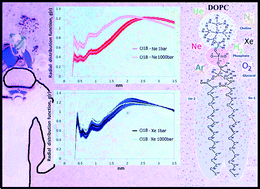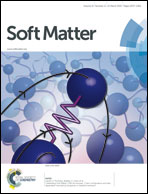Modelling of noble anaesthetic gases and high hydrostatic pressure effects in lipid bilayers†
Abstract
Our objective was to study molecular processes that might be responsible for inert gas narcosis and high-pressure nervous syndrome. The classical molecular dynamics trajectories (200 ns) of dioleoylphosphatidylcholine (DOPC) bilayers simulated by the Berger force field were evaluated for water and the atomic distribution of noble gases around DOPC molecules in the pressure range of 1–1000 bar and at a temperature of 310 K. Xenon and argon have been tested as model gases for general anaesthetics, and neon has been investigated for distortions that are potentially responsible for neurological tremors in hyperbaric conditions. The analysis of stacked radial pair distribution functions of DOPC headgroup atoms revealed the explicit solvation potential of the gas molecules, which correlates with their dimensions. The orientational dynamics of water molecules at the biomolecular interface should be considered as an influential factor, while excessive solvation effects appearing in the lumen of membrane-embedded ion channels could be a possible cause of inert gas narcosis. All the noble gases tested exhibit similar order parameter patterns for both DOPC acyl chains, which are opposite of the patterns found for the order parameter curve at high hydrostatic pressures in intact bilayers. This finding supports the ‘critical volume’ hypothesis of anaesthesia pressure reversal. The irregular lipid headgroup–water boundary observed in DOPC bilayers saturated with neon in the pressure range of 1–100 bar could be associated with the possible manifestation of neurological tremors at the atomic scale. The non-immobiliser neon also demonstrated the highest momentum impact on the normal component of the DOPC diffusion coefficient representing the monolayer undulation rate, which indicates that enhanced diffusivity rather than atomic size is the key factor.


 Please wait while we load your content...
Please wait while we load your content...